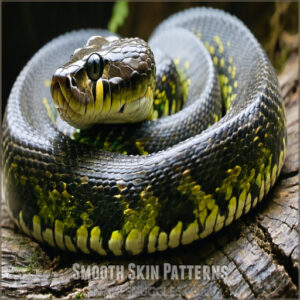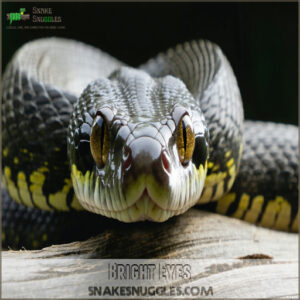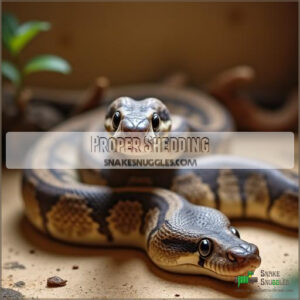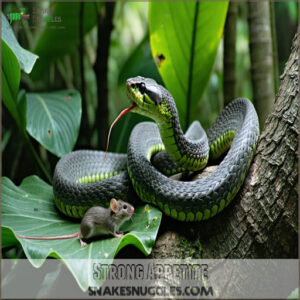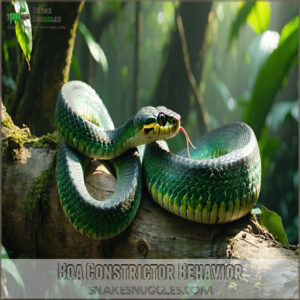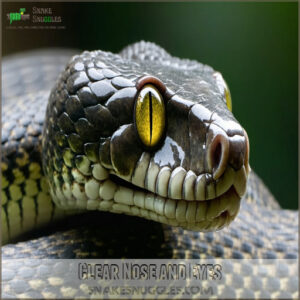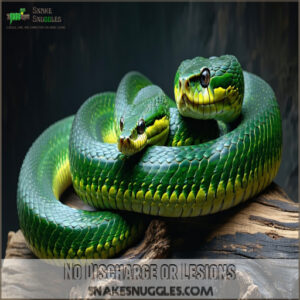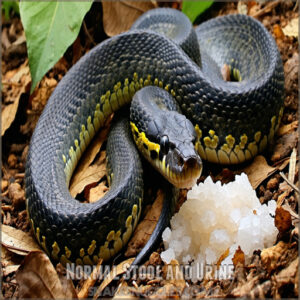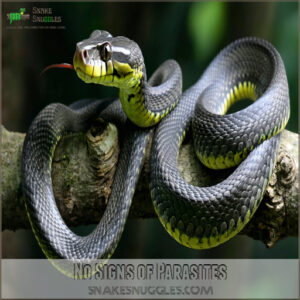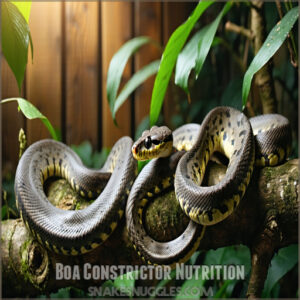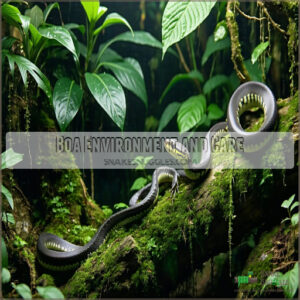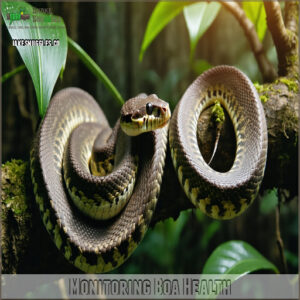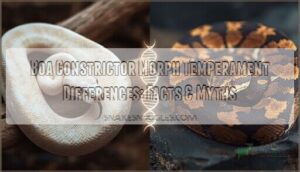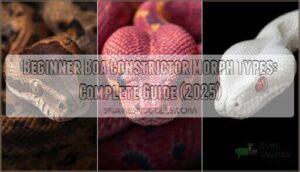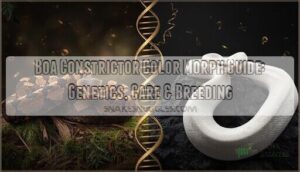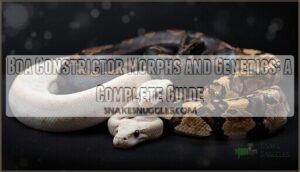This site is supported by our readers. We may earn a commission, at no cost to you, if you purchase through links.
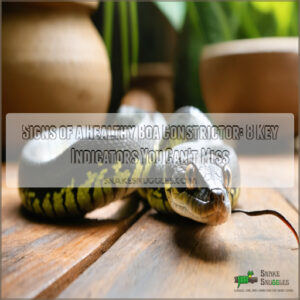 In the case of spotting the signs of a healthy boa constrictor, it’s all about the small details.
In the case of spotting the signs of a healthy boa constrictor, it’s all about the small details.
A bright-eyed boa with clear eyes, smooth glossy scales, and regular clean shedding is on the right track.
They should slither with purpose—active but calm, a little tongue-flicking here and there (like licking the air for updates).
A strong appetite is key too—enthusiastic feeding without regurgitation shows they’re thriving.
And let’s not forget their living space—proper temps, humidity, and cleanliness keep them in top shape.
Think of it like maintaining a cozy spa for your scaly friend.
Keep an eye out—healthy is happy!
Table Of Contents
- Key Takeaways
- Healthy Boa Characteristics
- Boa Constrictor Behavior
- Boa Health Indicators
- Boa Constrictor Nutrition
- Boa Environment and Care
- Monitoring Boa Health
- Frequently Asked Questions (FAQs)
- How do you know if a boa constrictor is healthy?
- How do I know if my boa is healthy?
- Are boa constrictors prone to diseases?
- How do I choose a healthy boa constrictor?
- What color is a boa constrictor?
- What is boa constrictor care?
- How do I tell if my boa is happy?
- How often should I hold my boa constrictor?
- What is a healthy boa shape?
- How do boas behave during mating season?
- Conclusion
Key Takeaways
- Keep an eye out for bright, clear eyes, smooth glossy scales, and a strong, muscular body—these are signs your boa’s healthy and thriving.
- A steady appetite is essential; a healthy boa eats enthusiastically and doesn’t regurgitate its meals.
- Ensure your boa’s environment has proper temperature gradients (88–90°F) and 40–75% humidity, along with regular cleaning to prevent health issues.
- Watch for active behavior, regular tongue flicking, and smooth, complete shedding as clear indicators of your boa’s well-being.
Healthy Boa Characteristics
You’ll want to keep an eye on your boa constrictor’s overall appearance, just like you’d notice if your best friend showed up wearing mismatched socks.
When your snake’s showing clear eyes that sparkle like diamonds, smooth scales that shine like fresh paint, and a body that’s as firm as a well-baked pretzel, you’ve got yourself one happy and healthy reptilian friend.
Smooth Skin Patterns
When checking your boa constrictor’s health, smooth skin patterns are your first clue to their wellbeing.
Your snake’s scales should be like a well-polished suit of armor – glossy and tight-fitting.
Here’s what to look for in healthy boa constrictor scales:
- Even color variations without patchy areas
- Smooth, overlapping scales with no gaps
- Subtle iridescence in good lighting
- No raised or damaged scales
- Clean, complete shedding pattern
This reorganization improves readability by grouping related concepts together, making it easier to understand the key points of healthy boa constrictor care.
Bright Eyes
You’ll want your boa constrictor’s eyes to be as bright as a freshly polished marble.
Clear, clean eyes with a healthy eye shine show you’ve got a happy snake on your hands.
When checking your boa’s vision health, look for a clear iris without any cloudiness or discharge.
Bright, alert eyes paired with regular tongue flicking are classic signs of a healthy boa constrictor.
Regular checks for boa health issues can help identify potential problems early on, ensuring your snake stays healthy and you can enjoy a happy snake.
Proper Shedding
After those bright, clear eyes comes another telltale sign of health: your boa’s shedding process.
Young snakes shed more frequently, with skin looking slightly saggy around the head and neck before the big event.
After shedding, inspect carefully for any stuck eye caps or tail skin – a smooth, complete shed signals your snake’s in tip-top shape.
Understanding shedding frequency factors is essential for maintaining a healthy boa constrictor.
Strong Appetite
After a smooth shedding process, your boa’s next health checkpoint is appetite. A strong hunger signals well-being in these slithery companions.
Healthy boas devour prey with enthusiasm, young ones munching weekly and adults feasting every few weeks. Watch for consistent feeding response signs – if your snake turns down meals or seems disinterested, it might be time to chat with a vet.
Ensuring proper habitat conditions, such as suitable temperatures for boa digestion, can also help maintain their appetite and overall health.
Boa Constrictor Behavior
Understanding your boa constrictor’s behavior is like learning a secret snake language that’ll help you spot when they’re feeling tip-top.
If you know what to look for, you’ll become a pro at reading your slithery friend’s mood and health faster than a snake can flick its tongue.
Active and Alert
When your boa constrictor moves like a well-oiled machine, you’re witnessing peak behavioral awareness.
An active snake explores its environment with purposeful movements, displaying keen resting patterns and responsive interaction signals.
Watch for consistent daytime activity and muscle tone that screams vitality.
Your snake’s alertness isn’t just movement—it’s a living, breathing indicator of excellent health.
Docile Temperament
As your snake chills from its previous active state, its docile temperament shines through. Boa constrictors are natural-born cuddle buddies when treated right.
Here’s why they’re the zen masters of the snake world:
- Friendly and relaxed with proper handling
- Not prone to random strikes or aggression
- Happy to explore but content to settle down
- Calm demeanor makes them great reptile companions
Their gentle nature is your ticket to a stress-free snake friendship.
Regular Tongue Flicking
Curiosity in boa constrictors manifests through their signature tongue flicking behavior.
You’ll notice your pet’s tongue darting out rhythmically, sampling the environment with its Jacobson’s organ.
These quick, frequent flicks – averaging about 8.5 per second – reveal your snake’s neurological health and alertness to its surroundings.
Good Muscle Mass
After watching your snake’s tongue dance through its environment, pay attention to its muscle mass—a telltale sign of health.
A robust boa should feel solid and well-developed when handled, with strong muscle tone that shows it’s active and thriving.
Think of it like a bodybuilder snake: lean, powerful, and ready to explore.
Weak muscles? That’s a red flag.
Boa Health Indicators
If you’re a boa constrictor owner, knowing your snake’s health indicators is essential for catching potential problems early.
Just like you’d monitor your pet dog or cat, keeping an eye on your boa’s appearance, behavior, and overall condition can help you spot warning signs before they become serious health issues.
Clear Nose and Eyes
After observing your boa’s active movements, shift your focus to its eyes and nose.
Crystal-clear eyes without cloudiness or discharge signal excellent health. Watch for bright, alert eyes that track movement smoothly.
A clean, mucus-free nose tells you your scaly friend’s respiratory system is in great shape.
These are your first clues to a thriving, healthy boa constrictor.
No Discharge or Lesions
Clear boa constrictor eyes are great, but don’t stop there—check for smooth, unbroken scales and no weird discharge.
Lesions or blisters? Big red flags.
Skin infection prevention starts with keeping their enclosure clean and humidity balanced.
Spotting early symptoms like redness or swelling can save you headaches later.
Healthy scales mean a happy, slither-ready snake!
Normal Stool and Urine
After checking for discharge, don’t forget to peek at your boa’s bathroom habits. Healthy bowel movements and clear urine are big snake health checks.
Here’s what to look for:
- Stool consistency: firm, not runny.
- Urine clarity: no cloudiness.
- Digestive health signs: no undigested prey bits.
- Hydration impact: regular urates (white waste).
- Stool changes: no sudden shifts.
Keep an eye out!
No Signs of Parasites
Parasites are sneaky troublemakers for boa constrictor wellness. Look for clean scales and smooth digestion—no weird bumps or regurgitation.
Parasite transmission risks drop with quarantine best practices and clean enclosures.
Spotting mites or ticks? That’s identifying external parasites! Quick fixes include parasite treatment options like vet-prescribed meds.
Stay sharp; prevention tips like hygiene and regular checks keep your boa thriving.
Boa Constrictor Nutrition
Feeding your boa the right way is like setting up a perfect buffet—just enough, not too much, and sized just right.
A healthy boa thrives on a balanced diet, proper feeding schedules, and prey that doesn’t resemble a wrestling match waiting to happen.
Proper Feeding Frequency
A healthy boa constrictor’s appetite tells you a lot.
Young boas stick to a diet of small prey every 5–7 days, while adults follow feeding patterns of every 3–4 weeks.
Adjust feeding intervals based on size and age—too much food can lead to issues.
Skipping meals might signal feeding problems or stress. Keep an eye on their behavior.
For guidance on how often to feed boa constrictors, consider age, health, and local climate changes to guarantee appropriate feeding practices.
Balanced Diet
You can’t just toss your boa the same snack every week—it’d be like us eating nothing but broccoli! A balanced boa constrictor diet isn’t tough but needs food variety.
Mix it up with:
- Frozen rodents (mice or rats).
- Chicks occasionally.
- Calcium/vitamin dusted meals.
- Prey suiting dietary needs, fitting their appetite.
For quality and convenience, consider purchasing frozen rodent food from reputable suppliers.
Keep feeding habits healthy to sidestep boa constrictor nutrition issues.
Appropriate Prey Size
When your boa looks hungry, prey size matters.
Stick to prey smaller than your snake’s widest mid-body part—that’s your golden rule for feeding safety. Oversized meals can lead to health problems or even regurgitation (yuck!).
Matching prey size keeps digestion smooth and your boa comfortable. Smart prey selection tips like this guarantee a happy, healthy boa constrictor appetite every time.
Avoiding Overfeeding
Feeding boas is simple, but overfeeding can sneak up on you.
Keep their appetite in check with smart feeding schedule tips:
- Space meals based on size—young boas eat weekly, adults every 3-4 weeks.
- Watch for weight changes; a pudgy boa isn’t healthy.
- Use prey size guidelines; avoid oversized meals.
- Recognize overfeeding signs like regurgitation or sluggishness.
Boa Environment and Care
Your boa’s environment is like its personal spa—keep it clean, cozy, and secure, and you’ll have a happy snake.
With proper temperatures, the right humidity, and some regular handling, your scaly friend will stay healthy and stress-free.
Proper Temperature Control
Getting the heat right means giving your boa zones to lounge in, like a cozy spa on one end and a chill lounge on the other. Proper temperature gradients help your snake feel at home.
Aim for warm spots around 88-90°F and a nighttime temperature range of 68-75°F. Use safe heating methods, thermometers, and keep thermometers placed strategically.
Perfect boa constrictor habitat vibes! For more guidance, explore the importance of accurate temperature monitoring in ensuring your boa’s health and comfort.
Humidity Levels
Keeping your boa constrictor’s humidity levels on point is key—think of it as their spa day! Aim for an optimal humidity range of 40-75%.
Use humidity monitoring tools, like a digital hygrometer, to avoid dry sheds.
A water bowl under heat helps too.
Stable levels in their enclosure, alongside a proper temperature gradient, keep their skin happy and healthy.
Clean and Secure Enclosure
A clean, secure boa constrictor enclosure isn’t just fancy talk—it’s essential.
Keep their habitat safe and spotless with these tips:
- Clean Weekly: Remove old substrate and waste.
- Choose Safe Substrate: No cedar or pine, they’re toxic!
- Disinfect Properly: Use reptile-safe cleaners.
- Check for Escapes: Tight lids keep your snake, well, your snake!
In addition, investing in a quality boa constrictor enclosure designed to meet their specific needs guarantees their comfort and safety.
Regular Handling and Socialization
A little patience and a gentle touch go a long way when building snake trust with your boa constrictor.
Regular handling keeps your snake comfortable with human interaction and strengthens your bond.
Use proper handling techniques—always support its body and avoid sudden moves.
This boosts its alertness and reinforces a calm, docile boa constrictor temperament that makes encounters stress-free.
Monitoring Boa Health
Keeping your boa healthy isn’t rocket science, but it does take some attention to detail.
By watching for signs of illness and keeping their environment clean, you’ll help your slithery friend stay happy and strong.
Regular Veterinary Check-ups
A clean enclosure helps your boa, but skipping routine veterinary checkups can be like ignoring your car’s oil light.
A reptile vet guarantees your boa constrictor’s health with diagnostic tools, preventative measures, and regular vet visit schedules.
Stick to health check protocols and keep medical record keeping organized.
It’s smart boa constrictor care that saves headaches (and scales) later.
Proper reptile vet care is essential for maintaining a healthy boa constrictor.
Watching for Signs of Illness
Spotting illness early is like stopping a small leak before it floods.
Watch your boa’s behavior closely. Here’s what to notice:
- Breathing Changes: Wheezing or open-mouth breathing? Not good.
- Eyes and Nose: Discharge, redness, or swelling spell trouble.
- Appetite Loss: Skipping meals isn’t normal.
- Odd Shedding: Clinging skin may point to issues.
Understanding boa constrictor health is essential for identifying these signs.
Regular health checks save lives!
Maintaining a Clean Environment
A dirty boa constrictor habitat is like inviting trouble, and nobody wants that.
Regular enclosure cleaning keeps your snake comfy and disease-free, tackle waste management quickly, scrub surfaces, and use safe disinfection methods.
Don’t forget humidity control and good ventilation systems – they’re lifesavers, as enclosure hygiene isn’t just boa constrictor care; it’s your snake’s ticket to a healthy, happy life.
Preventing Common Health Issues
Keeping your boa constrictor healthy isn’t rocket science—but it does take effort!
Focus on environmental control by nailing temperature and humidity.
Regular health checks and good nutrition tips go a long way in disease prevention.
Don’t skip routine cleanups to avoid boa constrictor health problems.
And hey, find a reptile vet—you need a pro for long-term care!
Frequently Asked Questions (FAQs)
How do you know if a boa constrictor is healthy?
A healthy boa’s like a perfectly tuned guitar—everything works harmoniously.
Expect clear, bright eyes, smooth skin, steady appetite, and no wheezing.
It should move confidently, flick its tongue often, and feel strong yet relaxed in your hands, embodying a steady appetite.
How do I know if my boa is healthy?
Your boa’s healthy if it’s active, flicks its tongue often, has clear eyes, smooth skin, and a strong appetite.
No wheezing, odd behavior, or funky shedding.
Think of it as happy, slithery energy!
Are boa constrictors prone to diseases?
Think of boas as sturdy adventurers, but even they aren’t invincible.
They’re prone to respiratory infections, scale rot, parasites, and serious conditions like Inclusion Body Disease.
Spotting issues early and maintaining their setup keeps them thriving.
How do I choose a healthy boa constrictor?
Pick a boa with clear eyes, smooth skin, and a strong grip—like a mini weightlifter!
Avoid ones that look sluggish or sickly, and double-check they’re eating well.
Trust your gut—it’s your best guide!
What color is a boa constrictor?
Boa constrictors often sport a mix of browns, tans, and blacks with unique patterns, almost like nature’s version of fancy wallpaper.
Some morphs flaunt vibrant reds or creamy whites, making each one strikingly individual.
What is boa constrictor care?
Caring for your boa’s like hosting a tropical guest—keep their space warm (82–90°F), humid, and spacious.
Toss in regular handling, proper meals (no oversized snacks), and check-ups, and you’ll have a happy, chill snake!
How do I tell if my boa is happy?
Your boa’s happy if it’s alert, flicking its tongue, exploring its space, and eating well.
Relaxed handling, smooth shedding, and no hissing or biting are great signs too—like a chilled-out, scaly roommate!
How often should I hold my boa constrictor?
Don’t worry—your boa won’t get annoyed with daily handling.
Aim for 2–3 times a week, around 10–20 minutes per session.
Consistent handling helps build trust, keeps them stress-free, and avoids them getting too shy.
What is a healthy boa shape?
A healthy boa should look like they’ve hit the reptile gym—muscular but not chunky, with a smooth, even body.
No saggy skin, sharp ribs, or lumps.
They should feel sturdy, not floppy, when handled.
How do boas behave during mating season?
During mating season, you’ll notice male boas becoming restless, often moving around more and “courting” females by nudging, rubbing, or intertwining tails.
Females may stay still, waiting for the perfect moment—like reptile romance!
Conclusion
You want your boa constrictor to be the picture of health, right?
Look for smooth scales, bright eyes, and those essential signs of a healthy boa constrictor—like solid muscle tone, steady appetite, and proper shedding.
Keep their spa-like setup in check with good temps, humidity, and a clean enclosure.
A happy boa’s calm but curious, flicking its tongue like it’s sniffing out secrets, and showing proper shedding and a steady appetite.
Stay tuned to these details, and your scaly pal will thrive!

